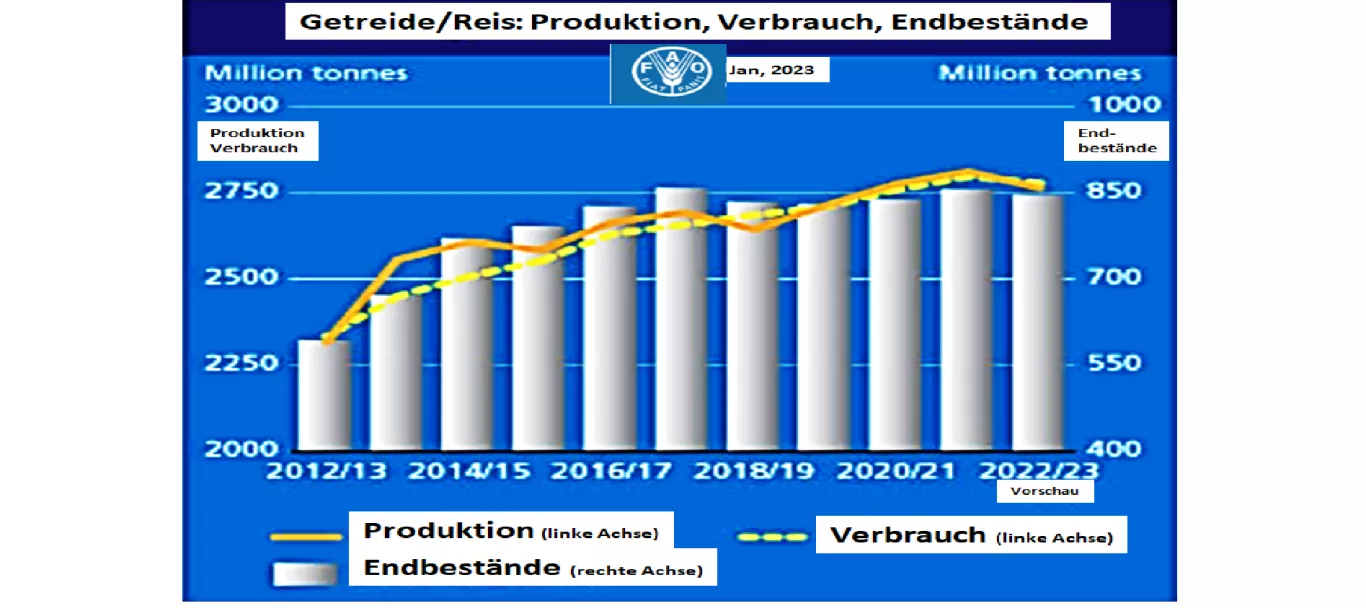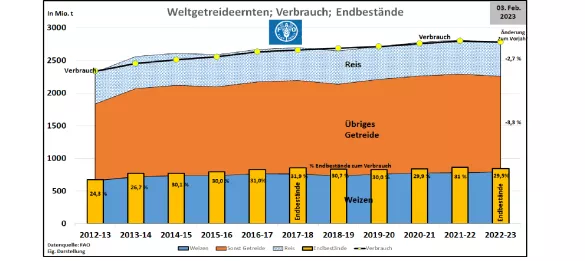Feb 2023: FAO updates global grain supply 2022/23 - first preview of crop 2023 The Food and Agriculture Organization of the United Nations (FAO) has in its latest Jan.2023 report on the situation in the world grain market compared to the Dec.2022 forecast Upward corrections made. Wheat is primarily affected by this, while the supply of corn is tighter. Estimates for rice were lowered by -1.7% from the previous month. The global wheat harvest is classified at 794 million t (previous year 778 million t). The higher production results are due to the above-average harvests in Russia and Australia. Consumption is said to be around 776 million tons. An increase in ending stocks to around 305 million t (previous year 294 million t) or 38.7% of consumption is thus predicted. The reserves of the major exporting countries amount to 18.2% of consumption (previous year 16.0%). The global rice harvest is reduced to around 511.6 million t (previous year 525 million t). The FAO estimates consumption at 519 million t (-3 million t compared to the previous year).The ending stock thus fell to 192.5 million t (previous year 197 million t). The reserves of the major exporting countries remain at a high level of just under 29.5% of consumption. The FAO cuts the remaining grain harvest with a focus on corn again to 1,459 million t (previous year 1,509 million t). Reductions were made for corn in the EU, USA and Russia. As a result, the Chinese corn harvest will be increased slightly Consumption is expected to fall to 1,482 million tons (previous year 1,504 million tons). Accordingly, the ending stocks will be reduced by around 17 million t to 347 million t. This shows the lowest level of supply in the last 10 years (22% final stock to consumption). The increases in global consumption of grain and rice in previous years as a result of increasing population and income are reduced by -0.7%. This takes place primarily in the poorer importing countries. Global production falls below consumption. World level inventories have not shown any improvement for 5 years. For the 2023 crop year , the FAO assumes that the area under cultivation for wheat will increase, which will be caused by higher prices.In the USA, wheat cultivation is said to have increased by 11%. In Canada, an increase in (summer) wheat acreage of +2% is expected. In contrast, a 40% reduction in wheat areas is assumed in the Ukraine. In Russia, too, the acreage is said to be smaller. However, against the background of persistently above-average fertilizer prices, lower yields per hectare are expected; even if fertilizer prices have fallen somewhat. The prospects of an improved supply situation in the future are to be classified as rather low; a market situation at the level of 2022 would already be considered favourable.



